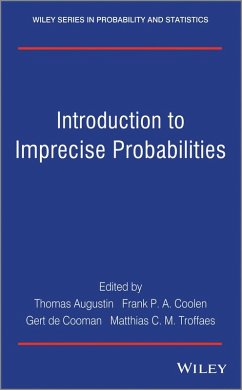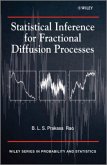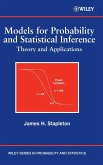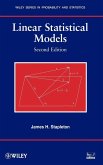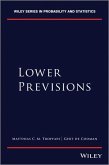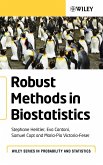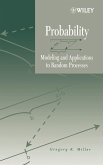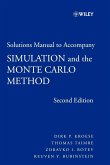Introduction to Imprecise Probabilities
Herausgegeben von Augustin, Thomas; Coolen, Frank P. A.; de Cooman, Gert; Troffaes, Matthias C. M.
Introduction to Imprecise Probabilities
Herausgegeben von Augustin, Thomas; Coolen, Frank P. A.; de Cooman, Gert; Troffaes, Matthias C. M.
- Gebundenes Buch
- Merkliste
- Auf die Merkliste
- Bewerten Bewerten
- Teilen
- Produkt teilen
- Produkterinnerung
- Produkterinnerung
In recent years, the theory has become widely accepted and has been further developed, but a detailed introduction is needed in order to make the material available and accessible to a wide audience. This will be the first book providing such an introduction, covering core theory and recent developments which can be applied to many application areas. All authors of individual chapters are leading researchers on the specific topics, assuring high quality and up-to-date contents.
An Introduction to Imprecise Probabilities provides a comprehensive introduction to imprecise probabilities,…mehr
Andere Kunden interessierten sich auch für
![Statistical Inference for Fractional Diffusion Processes Statistical Inference for Fractional Diffusion Processes]() B. L. S. Prakasa RaoStatistical Inference for Fractional Diffusion Processes112,99 €
B. L. S. Prakasa RaoStatistical Inference for Fractional Diffusion Processes112,99 €![Models for Probability and Statistical Inference Models for Probability and Statistical Inference]() James H. StapletonModels for Probability and Statistical Inference171,99 €
James H. StapletonModels for Probability and Statistical Inference171,99 €![Linear Statistical Models 2e Linear Statistical Models 2e]() James H. StapletonLinear Statistical Models 2e153,99 €
James H. StapletonLinear Statistical Models 2e153,99 €![Lower Previsions Lower Previsions]() Matthias C. M. TroffaesLower Previsions94,99 €
Matthias C. M. TroffaesLower Previsions94,99 €![Robust Methods in Biostatistics Robust Methods in Biostatistics]() Stephane HeritierRobust Methods in Biostatistics110,99 €
Stephane HeritierRobust Methods in Biostatistics110,99 €![Probability Probability]() Gregory K. MillerProbability215,99 €
Gregory K. MillerProbability215,99 €![Student Solutions Manual to Accompany Simulation and the Monte Carlo Method Student Solutions Manual to Accompany Simulation and the Monte Carlo Method]() Dirk P. KroeseStudent Solutions Manual to Accompany Simulation and the Monte Carlo Method39,99 €
Dirk P. KroeseStudent Solutions Manual to Accompany Simulation and the Monte Carlo Method39,99 €-
-
-
In recent years, the theory has become widely accepted and has been further developed, but a detailed introduction is needed in order to make the material available and accessible to a wide audience. This will be the first book providing such an introduction, covering core theory and recent developments which can be applied to many application areas. All authors of individual chapters are leading researchers on the specific topics, assuring high quality and up-to-date contents.
An Introduction to Imprecise Probabilities provides a comprehensive introduction to imprecise probabilities, including theory and applications reflecting the current state if the art. Each chapter is written by experts on the respective topics, including: Sets of desirable gambles; Coherent lower (conditional) previsions; Special cases and links to literature; Decision making; Graphical models; Classification; Reliability and risk assessment; Statistical inference; Structural judgments; Aspects of implementation (including elicitation and computation); Models in finance; Game-theoretic probability; Stochastic processes (including Markov chains); Engineering applications.
Essential reading for researchers in academia, research institutes and other organizations, as well as practitioners engaged in areas such as risk analysis and engineering.
An Introduction to Imprecise Probabilities provides a comprehensive introduction to imprecise probabilities, including theory and applications reflecting the current state if the art. Each chapter is written by experts on the respective topics, including: Sets of desirable gambles; Coherent lower (conditional) previsions; Special cases and links to literature; Decision making; Graphical models; Classification; Reliability and risk assessment; Statistical inference; Structural judgments; Aspects of implementation (including elicitation and computation); Models in finance; Game-theoretic probability; Stochastic processes (including Markov chains); Engineering applications.
Essential reading for researchers in academia, research institutes and other organizations, as well as practitioners engaged in areas such as risk analysis and engineering.
Produktdetails
- Produktdetails
- Wiley Series in Probability and Statistics
- Verlag: Wiley & Sons
- Artikelnr. des Verlages: 14597381000
- 1. Auflage
- Seitenzahl: 448
- Erscheinungstermin: Mai 2014
- Englisch
- Abmessung: 251mm x 176mm x 27mm
- Gewicht: 839g
- ISBN-13: 9780470973813
- ISBN-10: 0470973811
- Artikelnr.: 36898856
- Herstellerkennzeichnung
- Libri GmbH
- Europaallee 1
- 36244 Bad Hersfeld
- gpsr@libri.de
- Wiley Series in Probability and Statistics
- Verlag: Wiley & Sons
- Artikelnr. des Verlages: 14597381000
- 1. Auflage
- Seitenzahl: 448
- Erscheinungstermin: Mai 2014
- Englisch
- Abmessung: 251mm x 176mm x 27mm
- Gewicht: 839g
- ISBN-13: 9780470973813
- ISBN-10: 0470973811
- Artikelnr.: 36898856
- Herstellerkennzeichnung
- Libri GmbH
- Europaallee 1
- 36244 Bad Hersfeld
- gpsr@libri.de
Thomas Augustin, Department of Statistics, University of Munich, Germany. Frank Coolen, Department of Mathematical Sciences, Durham University, UK. Gert de Cooman, Research Professor in Uncertainty Modelling and Systems Science, Ghent University, Belgium. Matthias Troffaes, Department of Mathematical Sciences, Durham University, UK.
Introduction xiii A brief outline of this book xv Guide to the reader xvii Contributors xxi Acknowledgements xxvii 1 Desirability 1 Erik Quaeghebeur 1.1 Introduction 1 1.2 Reasoning about and with sets of desirable gambles 2 1.2.1 Rationality criteria 2 1.2.2 Assessments avoiding partial or sure loss 3 1.2.3 Coherent sets of desirable gambles 4 1.2.4 Natural extension 5 1.2.5 Desirability relative to subspaces with arbitrary vector orderings 5 1.3 Deriving and combining sets of desirable gambles 6 1.3.1 Gamble space transformations 6 1.3.2 Derived coherent sets of desirable gambles 7 1.3.3 Conditional sets of desirable gambles 8 1.3.4 Marginal sets of desirable gambles 8 1.3.5 Combining sets of desirable gambles 9 1.4 Partial preference orders 11 1.4.1 Strict preference 12 1.4.2 Nonstrict preference 12 1.4.3 Nonstrict preferences implied by strict ones 14 1.4.4 Strict preferences implied by nonstrict ones 15 1.5 Maximally committal sets of strictly desirable gambles 16 1.6 Relationships with other, nonequivalent models 18 1.6.1 Linear previsions 18 1.6.2 Credal sets 19 1.6.3 To lower and upper previsions 21 1.6.4 Simplified variants of desirability 22 1.6.5 From lower previsions 23 1.6.6 Conditional lower previsions 25 1.7 Further reading 26 Acknowledgements 27 2 Lower previsions 28 Enrique Miranda and Gert de Cooman 2.1 Introduction 28 2.2 Coherent lower previsions 29 2.2.1 Avoiding sure loss and coherence 31 2.2.2 Linear previsions 35 2.2.3 Sets of desirable gambles 39 2.2.4 Natural extension 40 2.3 Conditional lower previsions 42 2.3.1 Coherence of a finite number of conditional lower previsions 45 2.3.2 Natural extension of conditional lower previsions 47 2.3.3 Coherence of an unconditional and a conditional lower prevision 49 2.3.4 Updating with the regular extension 52 2.4 Further reading 53 2.4.1 The work of Williams 53 2.4.2 The work of Kuznetsov 54 2.4.3 The work of Weichselberger 54 Acknowledgements 55 3 Structural judgements 56 Enrique Miranda and Gert de Cooman 3.1 Introduction 56 3.2 Irrelevance and independence 57 3.2.1 Epistemic irrelevance 59 3.2.2 Epistemic independence 61 3.2.3 Envelopes of independent precise models 63 3.2.4 Strong independence 65 3.2.5 The formalist approach to independence 66 3.3 Invariance 67 3.3.1 Weak invariance 68 3.3.2 Strong invariance 69 3.4 Exchangeability 71 3.4.1 Representation theorem for finite sequences 72 3.4.2 Exchangeable natural extension 74 3.4.3 Exchangeable sequences 75 3.5 Further reading 77 3.5.1 Independence 77 3.5.2 Invariance 77 3.5.3 Exchangeability 77 Acknowledgements 78 4 Special cases 79 Sébastien Destercke and Didier Dubois 4.1 Introduction 79 4.2 Capacities and n-monotonicity 80 4.3 2-monotone capacities 81 4.4 Probability intervals on singletons 82 4.5
-monotone capacities 82 4.5.1 Constructing
-monotone capacities 83 4.5.2 Simple support functions 83 4.5.3 Further elements 84 4.6 Possibility distributions, p-boxes, clouds and related models 84 4.6.1 Possibility distributions 84 4.6.2 Fuzzy intervals 86 4.6.3 Clouds 87 4.6.4 p-boxes 88 4.7 Neighbourhood models 89 4.7.1 Pari-mutuel 89 4.7.2 Odds-ratio 90 4.7.3 Linear-vacuous 90 4.7.4 Relations between neighbourhood models 91 4.8 Summary 91 5 Other uncertainty theories based on capacities 93 Sébastien Destercke and Didier Dubois 5.1 Imprecise probability = modal logic + probability 95 5.1.1 Boolean possibility theory and modal logic 95 5.1.2 A unifying framework for capacity based uncertainty theories 97 5.2 From imprecise probabilities to belief functions and possibility theory 97 5.2.1 Random disjunctive sets 98 5.2.2 Numerical possibility theory 100 5.2.3 Overall picture 102 5.3 Discrepancies between uncertainty theories 102 5.3.1 Objectivist vs. Subjectivist standpoints 103 5.3.2 Discrepancies in conditioning 104 5.3.3 Discrepancies in notions of independence 107 5.3.4 Discrepancies in fusion operations 109 5.4 Further reading 112 6 Game-theoretic probability 114 Vladimir Vovk and Glenn Shafer 6.1 Introduction 114 6.2 A law of large numbers 115 6.3 A general forecasting protocol 118 6.4 The axiom of continuity 122 6.5 Doob's argument 124 6.6 Limit theorems of probability 127 6.7 Lévy's zero-one law 128 6.8 The axiom of continuity revisited 129 6.9 Further reading 132 Acknowledgements 134 7 Statistical inference 135 Thomas Augustin, Gero Walter, and Frank P. A. Coolen 7.1 Background and introduction 136 7.1.1 What is statistical inference? 136 7.1.2 (Parametric) statistical models and i.i.d. samples 137 7.1.3 Basic tasks and procedures of statistical inference 139 7.1.4 Some methodological distinctions 140 7.1.5 Examples: Multinomial and normal distribution 141 7.2 Imprecision in statistics, some general sources and motives 143 7.2.1 Model and data imprecision; sensitivity analysis and ontological views on imprecision 143 7.2.2 The robustness shock, sensitivity analysis 144 7.2.3 Imprecision as a modelling tool to express the quality of partial knowledge 145 7.2.4 The law of decreasing credibility 145 7.2.5 Imprecise sampling models: Typical models and motives 146 7.3 Some basic concepts of statistical models relying on imprecise probabilities 147 7.3.1 Most common classes of models and notation 147 7.3.2 Imprecise parametric statistical models and corresponding i.i.d. samples 148 7.4 Generalized Bayesian inference 149 7.4.1 Some selected results from traditional Bayesian statistics 150 7.4.2 Sets of precise prior distributions, robust Bayesian inference and the generalized Bayes rule 154 7.4.3 A closer exemplary look at a popular class of models: The IDM and other models based on sets of conjugate priors in exponential families 155 7.4.4 Some further comments and a brief look at other models for generalized Bayesian inference 164 7.5 Frequentist statistics with imprecise probabilities 165 7.5.1 The nonrobustness of classical frequentist methods 166 7.5.2 (Frequentist) hypothesis testing under imprecise probability: Huber-Strassen theory and extensions 169 7.5.3 Towards a frequentist estimation theory under imprecise probabilities - some basic criteria and first results 171 7.5.4 A brief outlook on frequentist methods 174 7.6 Nonparametric predictive inference 175 7.6.1 Overview 175 7.6.2 Applications and challenges 177 7.7 A brief sketch of some further approaches and aspects 178 7.8 Data imprecision, partial identification 179 7.8.1 Data imprecision 180 7.8.2 Cautious data completion 181 7.8.3 Partial identification and observationally equivalent models 183 7.8.4 A brief outlook on some further aspects 186 7.9 Some general further reading 187 7.10 Some general challenges 188 Acknowledgements 189 8 Decision making 190 Nathan Huntley, Robert Hable, and Matthias C. M. Troffaes 8.1 Non-sequential decision problems 190 8.1.1 Choosing from a set of gambles 191 8.1.2 Choice functions for coherent lower previsions 192 8.2 Sequential decision problems 197 8.2.1 Static sequential solutions: Normal form 198 8.2.2 Dynamic sequential solutions: Extensive form 199 8.3 Examples and applications 202 8.3.1 Ellsberg's paradox 202 8.3.2 Robust Bayesian statistics 205 9 Probabilistic graphical models 207 Alessandro Antonucci, Cassio P. de Campos, and Marco Zaffalon 9.1 Introduction 207 9.2 Credal sets 208 9.2.1 Definition and relation with lower previsions 208 9.2.2 Marginalization and conditioning 210 9.2.3 Composition 212 9.3 Independence 213 9.4 Credal networks 215 9.4.1 Nonseparately specified credal networks 217 9.5 Computing with credal networks 220 9.5.1 Credal networks updating 220 9.5.2 Modelling and updating with missing data 221 9.5.3 Algorithms for credal networks updating 223 9.5.4 Inference on credal networks as a multilinear programming task 224 9.6 Further reading 226 Acknowledgements 229 10 Classification 230 Giorgio Corani, Joaquín Abellán, Andrés Masegosa, Serafin Moral, and Marco Zaffalon 10.1 Introduction 230 10.2 Naive Bayes 231 10.2.1 Derivation of naive Bayes 232 10.3 Naive credal classifier (NCC) 233 10.3.1 Checking Credal-dominance 233 10.3.2 Particular behaviours of NCC 235 10.3.3 NCC2: Conservative treatment of missing data 236 10.4 Extensions and developments of the naive credal classifier 237 10.4.1 Lazy naive credal classifier 237 10.4.2 Credal model averaging 238 10.4.3 Profile-likelihood classifiers 239 10.4.4 Tree-augmented networks (TAN) 240 10.5 Tree-based credal classifiers 242 10.5.1 Uncertainty measures on credal sets: The maximum entropy function 242 10.5.2 Obtaining conditional probability intervals with the imprecise Dirichlet model 245 10.5.3 Classification procedure 246 10.6 Metrics, experiments and software 249 10.7 Scoring the conditional probability of the class 251 10.7.1 Software 251 10.7.2 Experiments 251 10.7.3 Experiments comparing conditional probabilities of the class 253 Acknowledgements 257 11 Stochastic processes 258 Filip Hermans and Damjan kulj 11.1 The classical characterization of stochastic processes 258 11.1.1 Basic definitions 258 11.1.2 Precise Markov chains 259 11.2 Event-driven random processes 261 11.3 Imprecise Markov chains 263 11.3.1 From precise to imprecise Markov chains 264 11.3.2 Imprecise Markov models under epistemic irrelevance 265 11.3.3 Imprecise Markov models under strong independence 268 11.3.4 When does the interpretation of independence (not) matter? 270 11.4 Limit behaviour of imprecise Markov chains 272 11.4.1 Metric properties of imprecise probability models 272 11.4.2 The Perron-Frobenius theorem 273 11.4.3 Invariant distributions 274 11.4.4 Coefficients of ergodicity 275 11.4.5 Coefficients of ergodicity for imprecise Markov chains 275 11.5 Further reading 277 12 Financial risk measurement 279 Paolo Vicig 12.1 Introduction 279 12.2 Imprecise previsions and betting 280 12.3 Imprecise previsions and risk measurement 282 12.3.1 Risk measures as imprecise previsions 283 12.3.2 Coherent risk measures 284 12.3.3 Convex risk measures (and previsions) 285 12.4 Further reading 289 13 Engineering 291 Michael Oberguggenberger 13.1 Introduction 291 13.2 Probabilistic dimensioning in a simple example 295 13.3 Random set modelling of the output variability 298 13.4 Sensitivity analysis 300 13.5 Hybrid models 301 13.6 Reliability analysis and decision making in engineering 302 13.7 Further reading 303 14 Reliability and risk 305 Frank P. A. Coolen and Lev V. Utkin 14.1 Introduction 305 14.2 Stress-strength reliability 306 14.3 Statistical inference in reliability and risk 310 14.4 Nonparametric predictive inference in reliability and risk 312 14.5 Discussion and research challenges 317 15 Elicitation 318 Michael Smithson 15.1 Methods and issues 318 15.2 Evaluating imprecise probability judgements 322 15.3 Factors affecting elicitation 324 15.4 Matching methods with purposes 327 15.5 Further reading 328 16 Computation 329 Matthias C. M. Troffaes and Robert Hable 16.1 Introduction 329 16.2 Natural extension 329 16.2.1 Conditional lower previsions with arbitrary domains 330 16.2.2 The Walley-Pelessoni-Vicig algorithm 331 16.2.3 Choquet integration 332 16.2.4 Möbius inverse 334 16.2.5 Linear-vacuous mixture 334 16.3 Decision making 335 16.3.1
-maximin,
-maximax and Hurwicz 335 16.3.2 Maximality 335 16.3.3 E-admissibility 336 16.3.4 Interval dominance 337 References 338 Author index 375 Subject index 385
-monotone capacities 82 4.5.1 Constructing
-monotone capacities 83 4.5.2 Simple support functions 83 4.5.3 Further elements 84 4.6 Possibility distributions, p-boxes, clouds and related models 84 4.6.1 Possibility distributions 84 4.6.2 Fuzzy intervals 86 4.6.3 Clouds 87 4.6.4 p-boxes 88 4.7 Neighbourhood models 89 4.7.1 Pari-mutuel 89 4.7.2 Odds-ratio 90 4.7.3 Linear-vacuous 90 4.7.4 Relations between neighbourhood models 91 4.8 Summary 91 5 Other uncertainty theories based on capacities 93 Sébastien Destercke and Didier Dubois 5.1 Imprecise probability = modal logic + probability 95 5.1.1 Boolean possibility theory and modal logic 95 5.1.2 A unifying framework for capacity based uncertainty theories 97 5.2 From imprecise probabilities to belief functions and possibility theory 97 5.2.1 Random disjunctive sets 98 5.2.2 Numerical possibility theory 100 5.2.3 Overall picture 102 5.3 Discrepancies between uncertainty theories 102 5.3.1 Objectivist vs. Subjectivist standpoints 103 5.3.2 Discrepancies in conditioning 104 5.3.3 Discrepancies in notions of independence 107 5.3.4 Discrepancies in fusion operations 109 5.4 Further reading 112 6 Game-theoretic probability 114 Vladimir Vovk and Glenn Shafer 6.1 Introduction 114 6.2 A law of large numbers 115 6.3 A general forecasting protocol 118 6.4 The axiom of continuity 122 6.5 Doob's argument 124 6.6 Limit theorems of probability 127 6.7 Lévy's zero-one law 128 6.8 The axiom of continuity revisited 129 6.9 Further reading 132 Acknowledgements 134 7 Statistical inference 135 Thomas Augustin, Gero Walter, and Frank P. A. Coolen 7.1 Background and introduction 136 7.1.1 What is statistical inference? 136 7.1.2 (Parametric) statistical models and i.i.d. samples 137 7.1.3 Basic tasks and procedures of statistical inference 139 7.1.4 Some methodological distinctions 140 7.1.5 Examples: Multinomial and normal distribution 141 7.2 Imprecision in statistics, some general sources and motives 143 7.2.1 Model and data imprecision; sensitivity analysis and ontological views on imprecision 143 7.2.2 The robustness shock, sensitivity analysis 144 7.2.3 Imprecision as a modelling tool to express the quality of partial knowledge 145 7.2.4 The law of decreasing credibility 145 7.2.5 Imprecise sampling models: Typical models and motives 146 7.3 Some basic concepts of statistical models relying on imprecise probabilities 147 7.3.1 Most common classes of models and notation 147 7.3.2 Imprecise parametric statistical models and corresponding i.i.d. samples 148 7.4 Generalized Bayesian inference 149 7.4.1 Some selected results from traditional Bayesian statistics 150 7.4.2 Sets of precise prior distributions, robust Bayesian inference and the generalized Bayes rule 154 7.4.3 A closer exemplary look at a popular class of models: The IDM and other models based on sets of conjugate priors in exponential families 155 7.4.4 Some further comments and a brief look at other models for generalized Bayesian inference 164 7.5 Frequentist statistics with imprecise probabilities 165 7.5.1 The nonrobustness of classical frequentist methods 166 7.5.2 (Frequentist) hypothesis testing under imprecise probability: Huber-Strassen theory and extensions 169 7.5.3 Towards a frequentist estimation theory under imprecise probabilities - some basic criteria and first results 171 7.5.4 A brief outlook on frequentist methods 174 7.6 Nonparametric predictive inference 175 7.6.1 Overview 175 7.6.2 Applications and challenges 177 7.7 A brief sketch of some further approaches and aspects 178 7.8 Data imprecision, partial identification 179 7.8.1 Data imprecision 180 7.8.2 Cautious data completion 181 7.8.3 Partial identification and observationally equivalent models 183 7.8.4 A brief outlook on some further aspects 186 7.9 Some general further reading 187 7.10 Some general challenges 188 Acknowledgements 189 8 Decision making 190 Nathan Huntley, Robert Hable, and Matthias C. M. Troffaes 8.1 Non-sequential decision problems 190 8.1.1 Choosing from a set of gambles 191 8.1.2 Choice functions for coherent lower previsions 192 8.2 Sequential decision problems 197 8.2.1 Static sequential solutions: Normal form 198 8.2.2 Dynamic sequential solutions: Extensive form 199 8.3 Examples and applications 202 8.3.1 Ellsberg's paradox 202 8.3.2 Robust Bayesian statistics 205 9 Probabilistic graphical models 207 Alessandro Antonucci, Cassio P. de Campos, and Marco Zaffalon 9.1 Introduction 207 9.2 Credal sets 208 9.2.1 Definition and relation with lower previsions 208 9.2.2 Marginalization and conditioning 210 9.2.3 Composition 212 9.3 Independence 213 9.4 Credal networks 215 9.4.1 Nonseparately specified credal networks 217 9.5 Computing with credal networks 220 9.5.1 Credal networks updating 220 9.5.2 Modelling and updating with missing data 221 9.5.3 Algorithms for credal networks updating 223 9.5.4 Inference on credal networks as a multilinear programming task 224 9.6 Further reading 226 Acknowledgements 229 10 Classification 230 Giorgio Corani, Joaquín Abellán, Andrés Masegosa, Serafin Moral, and Marco Zaffalon 10.1 Introduction 230 10.2 Naive Bayes 231 10.2.1 Derivation of naive Bayes 232 10.3 Naive credal classifier (NCC) 233 10.3.1 Checking Credal-dominance 233 10.3.2 Particular behaviours of NCC 235 10.3.3 NCC2: Conservative treatment of missing data 236 10.4 Extensions and developments of the naive credal classifier 237 10.4.1 Lazy naive credal classifier 237 10.4.2 Credal model averaging 238 10.4.3 Profile-likelihood classifiers 239 10.4.4 Tree-augmented networks (TAN) 240 10.5 Tree-based credal classifiers 242 10.5.1 Uncertainty measures on credal sets: The maximum entropy function 242 10.5.2 Obtaining conditional probability intervals with the imprecise Dirichlet model 245 10.5.3 Classification procedure 246 10.6 Metrics, experiments and software 249 10.7 Scoring the conditional probability of the class 251 10.7.1 Software 251 10.7.2 Experiments 251 10.7.3 Experiments comparing conditional probabilities of the class 253 Acknowledgements 257 11 Stochastic processes 258 Filip Hermans and Damjan kulj 11.1 The classical characterization of stochastic processes 258 11.1.1 Basic definitions 258 11.1.2 Precise Markov chains 259 11.2 Event-driven random processes 261 11.3 Imprecise Markov chains 263 11.3.1 From precise to imprecise Markov chains 264 11.3.2 Imprecise Markov models under epistemic irrelevance 265 11.3.3 Imprecise Markov models under strong independence 268 11.3.4 When does the interpretation of independence (not) matter? 270 11.4 Limit behaviour of imprecise Markov chains 272 11.4.1 Metric properties of imprecise probability models 272 11.4.2 The Perron-Frobenius theorem 273 11.4.3 Invariant distributions 274 11.4.4 Coefficients of ergodicity 275 11.4.5 Coefficients of ergodicity for imprecise Markov chains 275 11.5 Further reading 277 12 Financial risk measurement 279 Paolo Vicig 12.1 Introduction 279 12.2 Imprecise previsions and betting 280 12.3 Imprecise previsions and risk measurement 282 12.3.1 Risk measures as imprecise previsions 283 12.3.2 Coherent risk measures 284 12.3.3 Convex risk measures (and previsions) 285 12.4 Further reading 289 13 Engineering 291 Michael Oberguggenberger 13.1 Introduction 291 13.2 Probabilistic dimensioning in a simple example 295 13.3 Random set modelling of the output variability 298 13.4 Sensitivity analysis 300 13.5 Hybrid models 301 13.6 Reliability analysis and decision making in engineering 302 13.7 Further reading 303 14 Reliability and risk 305 Frank P. A. Coolen and Lev V. Utkin 14.1 Introduction 305 14.2 Stress-strength reliability 306 14.3 Statistical inference in reliability and risk 310 14.4 Nonparametric predictive inference in reliability and risk 312 14.5 Discussion and research challenges 317 15 Elicitation 318 Michael Smithson 15.1 Methods and issues 318 15.2 Evaluating imprecise probability judgements 322 15.3 Factors affecting elicitation 324 15.4 Matching methods with purposes 327 15.5 Further reading 328 16 Computation 329 Matthias C. M. Troffaes and Robert Hable 16.1 Introduction 329 16.2 Natural extension 329 16.2.1 Conditional lower previsions with arbitrary domains 330 16.2.2 The Walley-Pelessoni-Vicig algorithm 331 16.2.3 Choquet integration 332 16.2.4 Möbius inverse 334 16.2.5 Linear-vacuous mixture 334 16.3 Decision making 335 16.3.1
-maximin,
-maximax and Hurwicz 335 16.3.2 Maximality 335 16.3.3 E-admissibility 336 16.3.4 Interval dominance 337 References 338 Author index 375 Subject index 385
Introduction xiii A brief outline of this book xv Guide to the reader xvii Contributors xxi Acknowledgements xxvii 1 Desirability 1 Erik Quaeghebeur 1.1 Introduction 1 1.2 Reasoning about and with sets of desirable gambles 2 1.2.1 Rationality criteria 2 1.2.2 Assessments avoiding partial or sure loss 3 1.2.3 Coherent sets of desirable gambles 4 1.2.4 Natural extension 5 1.2.5 Desirability relative to subspaces with arbitrary vector orderings 5 1.3 Deriving and combining sets of desirable gambles 6 1.3.1 Gamble space transformations 6 1.3.2 Derived coherent sets of desirable gambles 7 1.3.3 Conditional sets of desirable gambles 8 1.3.4 Marginal sets of desirable gambles 8 1.3.5 Combining sets of desirable gambles 9 1.4 Partial preference orders 11 1.4.1 Strict preference 12 1.4.2 Nonstrict preference 12 1.4.3 Nonstrict preferences implied by strict ones 14 1.4.4 Strict preferences implied by nonstrict ones 15 1.5 Maximally committal sets of strictly desirable gambles 16 1.6 Relationships with other, nonequivalent models 18 1.6.1 Linear previsions 18 1.6.2 Credal sets 19 1.6.3 To lower and upper previsions 21 1.6.4 Simplified variants of desirability 22 1.6.5 From lower previsions 23 1.6.6 Conditional lower previsions 25 1.7 Further reading 26 Acknowledgements 27 2 Lower previsions 28 Enrique Miranda and Gert de Cooman 2.1 Introduction 28 2.2 Coherent lower previsions 29 2.2.1 Avoiding sure loss and coherence 31 2.2.2 Linear previsions 35 2.2.3 Sets of desirable gambles 39 2.2.4 Natural extension 40 2.3 Conditional lower previsions 42 2.3.1 Coherence of a finite number of conditional lower previsions 45 2.3.2 Natural extension of conditional lower previsions 47 2.3.3 Coherence of an unconditional and a conditional lower prevision 49 2.3.4 Updating with the regular extension 52 2.4 Further reading 53 2.4.1 The work of Williams 53 2.4.2 The work of Kuznetsov 54 2.4.3 The work of Weichselberger 54 Acknowledgements 55 3 Structural judgements 56 Enrique Miranda and Gert de Cooman 3.1 Introduction 56 3.2 Irrelevance and independence 57 3.2.1 Epistemic irrelevance 59 3.2.2 Epistemic independence 61 3.2.3 Envelopes of independent precise models 63 3.2.4 Strong independence 65 3.2.5 The formalist approach to independence 66 3.3 Invariance 67 3.3.1 Weak invariance 68 3.3.2 Strong invariance 69 3.4 Exchangeability 71 3.4.1 Representation theorem for finite sequences 72 3.4.2 Exchangeable natural extension 74 3.4.3 Exchangeable sequences 75 3.5 Further reading 77 3.5.1 Independence 77 3.5.2 Invariance 77 3.5.3 Exchangeability 77 Acknowledgements 78 4 Special cases 79 Sébastien Destercke and Didier Dubois 4.1 Introduction 79 4.2 Capacities and n-monotonicity 80 4.3 2-monotone capacities 81 4.4 Probability intervals on singletons 82 4.5
-monotone capacities 82 4.5.1 Constructing
-monotone capacities 83 4.5.2 Simple support functions 83 4.5.3 Further elements 84 4.6 Possibility distributions, p-boxes, clouds and related models 84 4.6.1 Possibility distributions 84 4.6.2 Fuzzy intervals 86 4.6.3 Clouds 87 4.6.4 p-boxes 88 4.7 Neighbourhood models 89 4.7.1 Pari-mutuel 89 4.7.2 Odds-ratio 90 4.7.3 Linear-vacuous 90 4.7.4 Relations between neighbourhood models 91 4.8 Summary 91 5 Other uncertainty theories based on capacities 93 Sébastien Destercke and Didier Dubois 5.1 Imprecise probability = modal logic + probability 95 5.1.1 Boolean possibility theory and modal logic 95 5.1.2 A unifying framework for capacity based uncertainty theories 97 5.2 From imprecise probabilities to belief functions and possibility theory 97 5.2.1 Random disjunctive sets 98 5.2.2 Numerical possibility theory 100 5.2.3 Overall picture 102 5.3 Discrepancies between uncertainty theories 102 5.3.1 Objectivist vs. Subjectivist standpoints 103 5.3.2 Discrepancies in conditioning 104 5.3.3 Discrepancies in notions of independence 107 5.3.4 Discrepancies in fusion operations 109 5.4 Further reading 112 6 Game-theoretic probability 114 Vladimir Vovk and Glenn Shafer 6.1 Introduction 114 6.2 A law of large numbers 115 6.3 A general forecasting protocol 118 6.4 The axiom of continuity 122 6.5 Doob's argument 124 6.6 Limit theorems of probability 127 6.7 Lévy's zero-one law 128 6.8 The axiom of continuity revisited 129 6.9 Further reading 132 Acknowledgements 134 7 Statistical inference 135 Thomas Augustin, Gero Walter, and Frank P. A. Coolen 7.1 Background and introduction 136 7.1.1 What is statistical inference? 136 7.1.2 (Parametric) statistical models and i.i.d. samples 137 7.1.3 Basic tasks and procedures of statistical inference 139 7.1.4 Some methodological distinctions 140 7.1.5 Examples: Multinomial and normal distribution 141 7.2 Imprecision in statistics, some general sources and motives 143 7.2.1 Model and data imprecision; sensitivity analysis and ontological views on imprecision 143 7.2.2 The robustness shock, sensitivity analysis 144 7.2.3 Imprecision as a modelling tool to express the quality of partial knowledge 145 7.2.4 The law of decreasing credibility 145 7.2.5 Imprecise sampling models: Typical models and motives 146 7.3 Some basic concepts of statistical models relying on imprecise probabilities 147 7.3.1 Most common classes of models and notation 147 7.3.2 Imprecise parametric statistical models and corresponding i.i.d. samples 148 7.4 Generalized Bayesian inference 149 7.4.1 Some selected results from traditional Bayesian statistics 150 7.4.2 Sets of precise prior distributions, robust Bayesian inference and the generalized Bayes rule 154 7.4.3 A closer exemplary look at a popular class of models: The IDM and other models based on sets of conjugate priors in exponential families 155 7.4.4 Some further comments and a brief look at other models for generalized Bayesian inference 164 7.5 Frequentist statistics with imprecise probabilities 165 7.5.1 The nonrobustness of classical frequentist methods 166 7.5.2 (Frequentist) hypothesis testing under imprecise probability: Huber-Strassen theory and extensions 169 7.5.3 Towards a frequentist estimation theory under imprecise probabilities - some basic criteria and first results 171 7.5.4 A brief outlook on frequentist methods 174 7.6 Nonparametric predictive inference 175 7.6.1 Overview 175 7.6.2 Applications and challenges 177 7.7 A brief sketch of some further approaches and aspects 178 7.8 Data imprecision, partial identification 179 7.8.1 Data imprecision 180 7.8.2 Cautious data completion 181 7.8.3 Partial identification and observationally equivalent models 183 7.8.4 A brief outlook on some further aspects 186 7.9 Some general further reading 187 7.10 Some general challenges 188 Acknowledgements 189 8 Decision making 190 Nathan Huntley, Robert Hable, and Matthias C. M. Troffaes 8.1 Non-sequential decision problems 190 8.1.1 Choosing from a set of gambles 191 8.1.2 Choice functions for coherent lower previsions 192 8.2 Sequential decision problems 197 8.2.1 Static sequential solutions: Normal form 198 8.2.2 Dynamic sequential solutions: Extensive form 199 8.3 Examples and applications 202 8.3.1 Ellsberg's paradox 202 8.3.2 Robust Bayesian statistics 205 9 Probabilistic graphical models 207 Alessandro Antonucci, Cassio P. de Campos, and Marco Zaffalon 9.1 Introduction 207 9.2 Credal sets 208 9.2.1 Definition and relation with lower previsions 208 9.2.2 Marginalization and conditioning 210 9.2.3 Composition 212 9.3 Independence 213 9.4 Credal networks 215 9.4.1 Nonseparately specified credal networks 217 9.5 Computing with credal networks 220 9.5.1 Credal networks updating 220 9.5.2 Modelling and updating with missing data 221 9.5.3 Algorithms for credal networks updating 223 9.5.4 Inference on credal networks as a multilinear programming task 224 9.6 Further reading 226 Acknowledgements 229 10 Classification 230 Giorgio Corani, Joaquín Abellán, Andrés Masegosa, Serafin Moral, and Marco Zaffalon 10.1 Introduction 230 10.2 Naive Bayes 231 10.2.1 Derivation of naive Bayes 232 10.3 Naive credal classifier (NCC) 233 10.3.1 Checking Credal-dominance 233 10.3.2 Particular behaviours of NCC 235 10.3.3 NCC2: Conservative treatment of missing data 236 10.4 Extensions and developments of the naive credal classifier 237 10.4.1 Lazy naive credal classifier 237 10.4.2 Credal model averaging 238 10.4.3 Profile-likelihood classifiers 239 10.4.4 Tree-augmented networks (TAN) 240 10.5 Tree-based credal classifiers 242 10.5.1 Uncertainty measures on credal sets: The maximum entropy function 242 10.5.2 Obtaining conditional probability intervals with the imprecise Dirichlet model 245 10.5.3 Classification procedure 246 10.6 Metrics, experiments and software 249 10.7 Scoring the conditional probability of the class 251 10.7.1 Software 251 10.7.2 Experiments 251 10.7.3 Experiments comparing conditional probabilities of the class 253 Acknowledgements 257 11 Stochastic processes 258 Filip Hermans and Damjan kulj 11.1 The classical characterization of stochastic processes 258 11.1.1 Basic definitions 258 11.1.2 Precise Markov chains 259 11.2 Event-driven random processes 261 11.3 Imprecise Markov chains 263 11.3.1 From precise to imprecise Markov chains 264 11.3.2 Imprecise Markov models under epistemic irrelevance 265 11.3.3 Imprecise Markov models under strong independence 268 11.3.4 When does the interpretation of independence (not) matter? 270 11.4 Limit behaviour of imprecise Markov chains 272 11.4.1 Metric properties of imprecise probability models 272 11.4.2 The Perron-Frobenius theorem 273 11.4.3 Invariant distributions 274 11.4.4 Coefficients of ergodicity 275 11.4.5 Coefficients of ergodicity for imprecise Markov chains 275 11.5 Further reading 277 12 Financial risk measurement 279 Paolo Vicig 12.1 Introduction 279 12.2 Imprecise previsions and betting 280 12.3 Imprecise previsions and risk measurement 282 12.3.1 Risk measures as imprecise previsions 283 12.3.2 Coherent risk measures 284 12.3.3 Convex risk measures (and previsions) 285 12.4 Further reading 289 13 Engineering 291 Michael Oberguggenberger 13.1 Introduction 291 13.2 Probabilistic dimensioning in a simple example 295 13.3 Random set modelling of the output variability 298 13.4 Sensitivity analysis 300 13.5 Hybrid models 301 13.6 Reliability analysis and decision making in engineering 302 13.7 Further reading 303 14 Reliability and risk 305 Frank P. A. Coolen and Lev V. Utkin 14.1 Introduction 305 14.2 Stress-strength reliability 306 14.3 Statistical inference in reliability and risk 310 14.4 Nonparametric predictive inference in reliability and risk 312 14.5 Discussion and research challenges 317 15 Elicitation 318 Michael Smithson 15.1 Methods and issues 318 15.2 Evaluating imprecise probability judgements 322 15.3 Factors affecting elicitation 324 15.4 Matching methods with purposes 327 15.5 Further reading 328 16 Computation 329 Matthias C. M. Troffaes and Robert Hable 16.1 Introduction 329 16.2 Natural extension 329 16.2.1 Conditional lower previsions with arbitrary domains 330 16.2.2 The Walley-Pelessoni-Vicig algorithm 331 16.2.3 Choquet integration 332 16.2.4 Möbius inverse 334 16.2.5 Linear-vacuous mixture 334 16.3 Decision making 335 16.3.1
-maximin,
-maximax and Hurwicz 335 16.3.2 Maximality 335 16.3.3 E-admissibility 336 16.3.4 Interval dominance 337 References 338 Author index 375 Subject index 385
-monotone capacities 82 4.5.1 Constructing
-monotone capacities 83 4.5.2 Simple support functions 83 4.5.3 Further elements 84 4.6 Possibility distributions, p-boxes, clouds and related models 84 4.6.1 Possibility distributions 84 4.6.2 Fuzzy intervals 86 4.6.3 Clouds 87 4.6.4 p-boxes 88 4.7 Neighbourhood models 89 4.7.1 Pari-mutuel 89 4.7.2 Odds-ratio 90 4.7.3 Linear-vacuous 90 4.7.4 Relations between neighbourhood models 91 4.8 Summary 91 5 Other uncertainty theories based on capacities 93 Sébastien Destercke and Didier Dubois 5.1 Imprecise probability = modal logic + probability 95 5.1.1 Boolean possibility theory and modal logic 95 5.1.2 A unifying framework for capacity based uncertainty theories 97 5.2 From imprecise probabilities to belief functions and possibility theory 97 5.2.1 Random disjunctive sets 98 5.2.2 Numerical possibility theory 100 5.2.3 Overall picture 102 5.3 Discrepancies between uncertainty theories 102 5.3.1 Objectivist vs. Subjectivist standpoints 103 5.3.2 Discrepancies in conditioning 104 5.3.3 Discrepancies in notions of independence 107 5.3.4 Discrepancies in fusion operations 109 5.4 Further reading 112 6 Game-theoretic probability 114 Vladimir Vovk and Glenn Shafer 6.1 Introduction 114 6.2 A law of large numbers 115 6.3 A general forecasting protocol 118 6.4 The axiom of continuity 122 6.5 Doob's argument 124 6.6 Limit theorems of probability 127 6.7 Lévy's zero-one law 128 6.8 The axiom of continuity revisited 129 6.9 Further reading 132 Acknowledgements 134 7 Statistical inference 135 Thomas Augustin, Gero Walter, and Frank P. A. Coolen 7.1 Background and introduction 136 7.1.1 What is statistical inference? 136 7.1.2 (Parametric) statistical models and i.i.d. samples 137 7.1.3 Basic tasks and procedures of statistical inference 139 7.1.4 Some methodological distinctions 140 7.1.5 Examples: Multinomial and normal distribution 141 7.2 Imprecision in statistics, some general sources and motives 143 7.2.1 Model and data imprecision; sensitivity analysis and ontological views on imprecision 143 7.2.2 The robustness shock, sensitivity analysis 144 7.2.3 Imprecision as a modelling tool to express the quality of partial knowledge 145 7.2.4 The law of decreasing credibility 145 7.2.5 Imprecise sampling models: Typical models and motives 146 7.3 Some basic concepts of statistical models relying on imprecise probabilities 147 7.3.1 Most common classes of models and notation 147 7.3.2 Imprecise parametric statistical models and corresponding i.i.d. samples 148 7.4 Generalized Bayesian inference 149 7.4.1 Some selected results from traditional Bayesian statistics 150 7.4.2 Sets of precise prior distributions, robust Bayesian inference and the generalized Bayes rule 154 7.4.3 A closer exemplary look at a popular class of models: The IDM and other models based on sets of conjugate priors in exponential families 155 7.4.4 Some further comments and a brief look at other models for generalized Bayesian inference 164 7.5 Frequentist statistics with imprecise probabilities 165 7.5.1 The nonrobustness of classical frequentist methods 166 7.5.2 (Frequentist) hypothesis testing under imprecise probability: Huber-Strassen theory and extensions 169 7.5.3 Towards a frequentist estimation theory under imprecise probabilities - some basic criteria and first results 171 7.5.4 A brief outlook on frequentist methods 174 7.6 Nonparametric predictive inference 175 7.6.1 Overview 175 7.6.2 Applications and challenges 177 7.7 A brief sketch of some further approaches and aspects 178 7.8 Data imprecision, partial identification 179 7.8.1 Data imprecision 180 7.8.2 Cautious data completion 181 7.8.3 Partial identification and observationally equivalent models 183 7.8.4 A brief outlook on some further aspects 186 7.9 Some general further reading 187 7.10 Some general challenges 188 Acknowledgements 189 8 Decision making 190 Nathan Huntley, Robert Hable, and Matthias C. M. Troffaes 8.1 Non-sequential decision problems 190 8.1.1 Choosing from a set of gambles 191 8.1.2 Choice functions for coherent lower previsions 192 8.2 Sequential decision problems 197 8.2.1 Static sequential solutions: Normal form 198 8.2.2 Dynamic sequential solutions: Extensive form 199 8.3 Examples and applications 202 8.3.1 Ellsberg's paradox 202 8.3.2 Robust Bayesian statistics 205 9 Probabilistic graphical models 207 Alessandro Antonucci, Cassio P. de Campos, and Marco Zaffalon 9.1 Introduction 207 9.2 Credal sets 208 9.2.1 Definition and relation with lower previsions 208 9.2.2 Marginalization and conditioning 210 9.2.3 Composition 212 9.3 Independence 213 9.4 Credal networks 215 9.4.1 Nonseparately specified credal networks 217 9.5 Computing with credal networks 220 9.5.1 Credal networks updating 220 9.5.2 Modelling and updating with missing data 221 9.5.3 Algorithms for credal networks updating 223 9.5.4 Inference on credal networks as a multilinear programming task 224 9.6 Further reading 226 Acknowledgements 229 10 Classification 230 Giorgio Corani, Joaquín Abellán, Andrés Masegosa, Serafin Moral, and Marco Zaffalon 10.1 Introduction 230 10.2 Naive Bayes 231 10.2.1 Derivation of naive Bayes 232 10.3 Naive credal classifier (NCC) 233 10.3.1 Checking Credal-dominance 233 10.3.2 Particular behaviours of NCC 235 10.3.3 NCC2: Conservative treatment of missing data 236 10.4 Extensions and developments of the naive credal classifier 237 10.4.1 Lazy naive credal classifier 237 10.4.2 Credal model averaging 238 10.4.3 Profile-likelihood classifiers 239 10.4.4 Tree-augmented networks (TAN) 240 10.5 Tree-based credal classifiers 242 10.5.1 Uncertainty measures on credal sets: The maximum entropy function 242 10.5.2 Obtaining conditional probability intervals with the imprecise Dirichlet model 245 10.5.3 Classification procedure 246 10.6 Metrics, experiments and software 249 10.7 Scoring the conditional probability of the class 251 10.7.1 Software 251 10.7.2 Experiments 251 10.7.3 Experiments comparing conditional probabilities of the class 253 Acknowledgements 257 11 Stochastic processes 258 Filip Hermans and Damjan kulj 11.1 The classical characterization of stochastic processes 258 11.1.1 Basic definitions 258 11.1.2 Precise Markov chains 259 11.2 Event-driven random processes 261 11.3 Imprecise Markov chains 263 11.3.1 From precise to imprecise Markov chains 264 11.3.2 Imprecise Markov models under epistemic irrelevance 265 11.3.3 Imprecise Markov models under strong independence 268 11.3.4 When does the interpretation of independence (not) matter? 270 11.4 Limit behaviour of imprecise Markov chains 272 11.4.1 Metric properties of imprecise probability models 272 11.4.2 The Perron-Frobenius theorem 273 11.4.3 Invariant distributions 274 11.4.4 Coefficients of ergodicity 275 11.4.5 Coefficients of ergodicity for imprecise Markov chains 275 11.5 Further reading 277 12 Financial risk measurement 279 Paolo Vicig 12.1 Introduction 279 12.2 Imprecise previsions and betting 280 12.3 Imprecise previsions and risk measurement 282 12.3.1 Risk measures as imprecise previsions 283 12.3.2 Coherent risk measures 284 12.3.3 Convex risk measures (and previsions) 285 12.4 Further reading 289 13 Engineering 291 Michael Oberguggenberger 13.1 Introduction 291 13.2 Probabilistic dimensioning in a simple example 295 13.3 Random set modelling of the output variability 298 13.4 Sensitivity analysis 300 13.5 Hybrid models 301 13.6 Reliability analysis and decision making in engineering 302 13.7 Further reading 303 14 Reliability and risk 305 Frank P. A. Coolen and Lev V. Utkin 14.1 Introduction 305 14.2 Stress-strength reliability 306 14.3 Statistical inference in reliability and risk 310 14.4 Nonparametric predictive inference in reliability and risk 312 14.5 Discussion and research challenges 317 15 Elicitation 318 Michael Smithson 15.1 Methods and issues 318 15.2 Evaluating imprecise probability judgements 322 15.3 Factors affecting elicitation 324 15.4 Matching methods with purposes 327 15.5 Further reading 328 16 Computation 329 Matthias C. M. Troffaes and Robert Hable 16.1 Introduction 329 16.2 Natural extension 329 16.2.1 Conditional lower previsions with arbitrary domains 330 16.2.2 The Walley-Pelessoni-Vicig algorithm 331 16.2.3 Choquet integration 332 16.2.4 Möbius inverse 334 16.2.5 Linear-vacuous mixture 334 16.3 Decision making 335 16.3.1
-maximin,
-maximax and Hurwicz 335 16.3.2 Maximality 335 16.3.3 E-admissibility 336 16.3.4 Interval dominance 337 References 338 Author index 375 Subject index 385

